

![]()
BORDER COLLIE COUSINS
THE AUSTRALIAN SHEPHERD
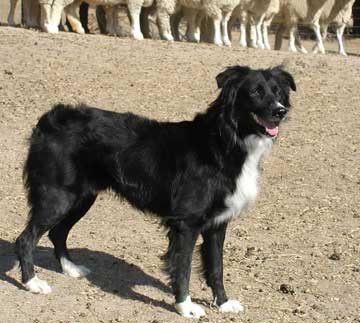
Las Rocosa Ritchie
"a true working Australian Shepherd"
(Photo courtesy of Jeanne Joy Hartnagle-Taylor)
Despite its name, the Australian Shepherd is an American breed, developed in North America from imported British working collies of the 19th century, though other types have played a role. Its history is controversial, though why that should be is puzzling. Although there are numerous points of view, space permits me to only quote from two sources, each of whom is a respected and knowledgeable herding dog historian. They maintain opposing viewpoints to some extent, but I believe that both views can be reconciled.
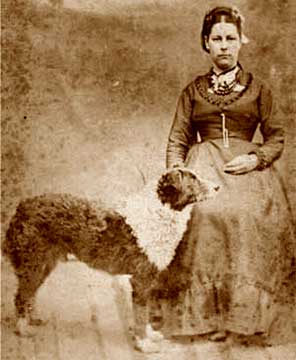 A late 19th century photo of a woman with an Australian Shepherd. Note the bobbed tail.
A late 19th century photo of a woman with an Australian Shepherd. Note the bobbed tail.
Linda Rorem is a herding dog historian, founder of the American Herding Breeds Association, and an all-breeds herding dog trainer and trials judge both in the USA and abroad. She maintains a website called "Herding On The Web" and has written articles on herding breeds for many magazines.
According to Linda Rorem, "Histories of California relate that although there had been many flocks of sheep at the Spanish missions, the number of sheep in the Far West had greatly declined by...the end of the 1840s. The [California] Gold Rush [1841-1855] and the [American] Civil War [1861-1865] brought about a great demand for mutton and wool. To meet this demand, large flocks were driven to the Far West from the Midwest and from New Mexico. Sheep were brought around [Cape] Horn from the Eastern states, and imported from Australia. Dogs accompanying these flocks, along with later arrivals, would figure in the background of the Australian Shepherd."
Rorem points out that dogs accompanying flocks from New Mexico were of the large, guardian-type Spanish dogs, and not the smaller herding type dogs, and these dogs very likely interbred with collies brought from Britain and elsewhere in the United States. Australian Shepherd is generally a bobtailed breed. Rorem contends that bobtails often occurred in litters of both working and early show collies, and this trait was selected for when the Australian Shepherd was being developed. However, even today, tailed dogs are born into Australian Shepherd litters, and are docked; and there are a few breeders who purposely breed tailed Australian Shepherds.
Rorem contends that because the kennel clubs dominated the name "collie" for their registered version, in the western United States the working collies came to be known as Australian Shepherds. Shipments of sheep came from Australia, and the dogs that accompanied them may have also have contributed to the name. Rorem says "[t]he name 'Australian Shepherd' is a name of long standing in the American West where the modern breed was developed."
While the Australian Shepherd comes in many colors similar to the Border Collie, blue merle is predominant in the breed. Of the blue merle color, Rorem says that "the original working collie was rarely sable in color, but was usually black with white and/or tan markings, or blue merle."
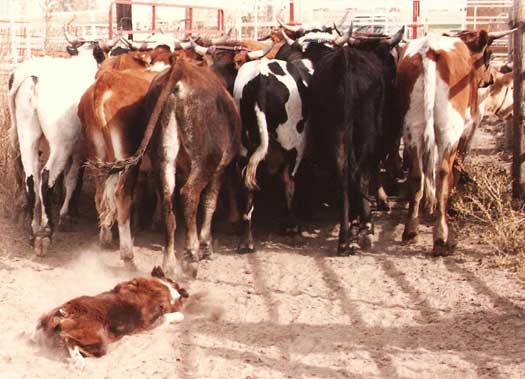
Hartnagle's Rocasa Christophene, a working Australian Shepherd cowdog,
low heeling Corrientes steers to avoid being kicked.
(Photo courtesy of Jeanne Joy Hartnagle-Taylor from the Hartnagle file.)
Jeanne Joy Hartnagle-Taylor is the third of four generations in association with stockdogs. She has done contract herding, worked wild bison bulls and cattle with her Australian Shepherds for the Department of the Interior, exhibited her dogs at livestock events, fairs, rodeos, and in herding trials. She has judged championship trials and given seminars in North America and Europe. She has written for numerous magazines and authored several books on the Australian Shepherd.

An old photo (1978 or 1979) of Las Rocosa Charlie Glass working sheep in Colorado.
(Photo courtesy of Jeanne Joy Hartnagle-Taylor from the Hartnagle file.)
According to Hartnagle-Taylor, "[n]ot all Basques who came to the United States to herd sheep on western ranges were shepherds in their homeland. However, a fair number of the[m] were. And when they came to the United States they brought their dogs with them. They arrived on a three-year visa under contract with the Western Range Association. When they got here, they wrote home and told their brothers to join them, [and] when they did they brought their dogs [too]. During that time in history large numbers of Basques with their sheepdogs were recruited into the western sheep ranches due to the severe labor shortage created in the 1940s and 1950s."[4]Hartnagle-Taylor points to the Carea Leonˇs, a red, black, or blue merle collie-type dog that has been used to herd sheep in Spain for hundreds of years (we will hear more about this breed in the next article in this series) as one of the contributors to the Australian Shepherd. She also mentions the German Tiger, which is a German shepherd dog of collie-type, and blue merle, which may have been a contributor to the gene pool of the Australian Shepherd (and perhaps to the Australian Koolie gene pool as well).
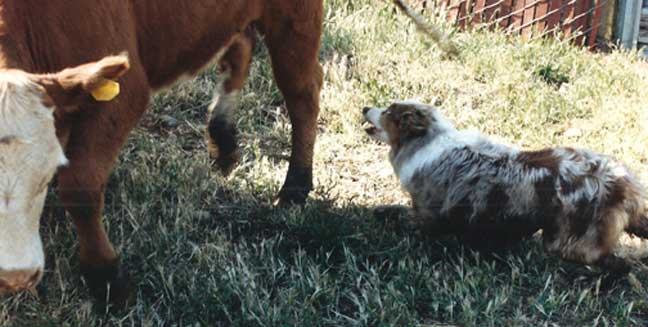
Blue merle Las Rocosa Bonny Kyle moving stubborn cattle, 1989.
(Photo courtesy of Jeanne Joy Hartnagle-Taylor from the Hartnagle file.)
Hartnagle-Taylor makes a case for the blue merle coloring having originated in the Basque influx as well (as per the Carea Leonˇs, above). Unfortunately, since merle is a possibility in all the collie breeds, merle in one breed does not necessarily indicate descent from another breed where merle is prevalent, though it doesn't rule it out either. Color depends on what is selected for. Because of the Australian Shepherd's bobtail, Hartnagle-Taylor makesa connection between it and the Old Welsh Bobtail. There may indeed be one, but unfortunately, even with genetic testing, all the current collie breeds may be so closely related as to make some special connection between just two of them impossible to determine. However, I don't know how bobtailedness is inherited, so the possibility of a connection exists, and I hope someday it can be proved.
While these two origin theories have also yet to be proved, it is quite possible that both are true. There were likely many contributing factors in the development of the Australian Shepherd. is no evidence, however, that the breed actually developed in Australia, and neither "side" makes that claim. In working style, the Australian Shepherd is a loose-eyed, upright worker.
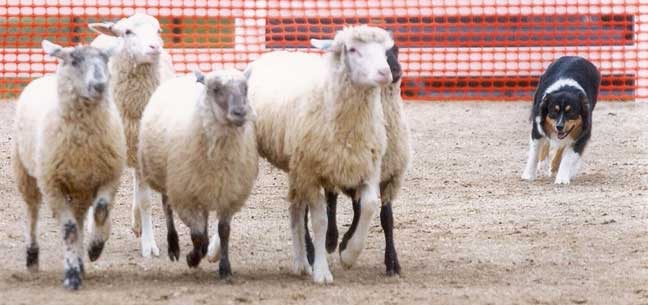
"Spirit", an Australian Shepherd belonging to Sheila Webster Boneham,
at the 2008 Australian Shepherd Club of America National Trial.
Resources:

Australian Shepherd Club of America (not affiliated with the AKC, the ASCA holds their own shows and trials events. They maintain a breed standard and a working description.
Boneham, Sheila W. The Guide to Owning an Australian Shepherd, T.F.H. Publications, Inc, 2001.
Hartnagle's Las Rocosa Australian Shepherds
Hartnagle-Taylor, Jeanne Joy. "The History of Australian Shepherds".
All About Aussies: The Australian Shepherd From A To Z, 2005.
All About Aussies: The Complete Handbook on Australian Shepherds, 1989.
Stockdog Savvy with Ty Taylor, 2010.
Rorem, Linda. "A View of Australian Shepherd History", Dog World magazine, 1987; revised 2010, and can be found on Rorem's website, Herding on the Web

United States Australian Shepherd Association (AKC affiliate).
Copyright © 2013 by Carole L. Presberg
Return to
![]()
BORDER COLLIE COUSINS
THE OTHER WEB PAGES WE MAINTAIN
These web pages are copyright ©2013
and maintained by webmeistress Carole Presberg
with technical help from webwizard David Presberg
ALL RIGHTS RESERVED
If you are interested in using ANY material on this website, you MUST first ask for permission.